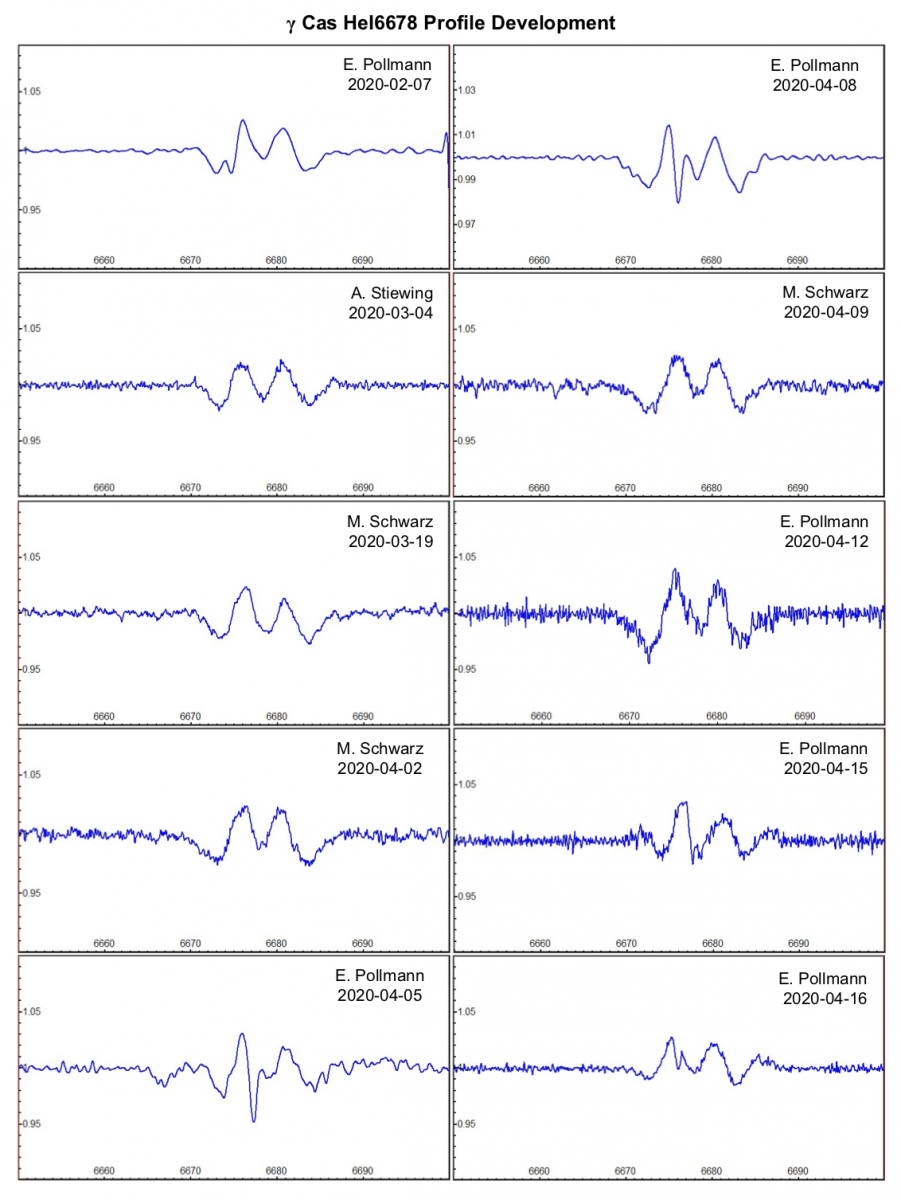Reminder: High-resolution spectroscopy (10,000 or higher) is needed. - Elizabeth O. Waagen, 1 February 2021
June 17, 2020
AAVSO Forum threads (scroll to the bottom of a thread for latest posts):
- Campaigns and Observation Reports: https://www.aavso.org/campaign-monitoring-helium-double-peak-emission-6678-å
- Spectroscopy: https://www.aavso.org/campaign-monitoring-helium-double-peak-emission-6678
Further to AAVSO Alert Notice 694 (Spectroscopy of gamma Cas requested), Principal Investigator Ernst Pollmann writes:
"My investigation of the variability of the HeI6678 emission of gamma Cas is continuing, and I am asking for your assistance in obtaining spectra, particularly high resolution spectra.
"The HeI 6678 Å line in gamma Cas exhibits double-peaked emissions with the well-known V/R variations (changes in the relative strength of the shorter wavelength, “violet”, to the longer wavelength, “red”, peak) on the timescale of several years as well as within a few hours.
"Usually HeI lines like 6678 Å are formed in hot circumstellar (CS) regions close to the star, and therefore often show more localized activity and their V and R emissions can be unequal.
"The V and R emissions are emitted along lines of sight ’to the side’ of the Be star, where the doppler orbital motions cause them to be displaced away from line center. In many cases, like gas the disk extends ‘upward’ (and ‘downward’) from the equator, so that part of the HeI gas is in the foreground in front of the star. This region is cooler than the star and therefore absorbs some of the disk photospheric contribution behind it.
"That means an observer is measuring a collection of straight ‘lines of sight’, each of which goes through a point on the CS disk to an end point on the stellar surface. An observer looking at the flux of any line of sight will see the absorption due to the stellar disk from the background point on the star’s surface. But the line of sight is infinitesimally narrow (by definition) so the stellar line profile at that point will be un-broadened, not broadened.
"The HeI 6678 double-peaked emission is furthermore filled by a large part of the rotationally broadened photospheric absorption core. The whole line is very weak and can only be measured reliably on the spectra with high S/N. The emission peaks rise only a few percent above the continuum level.
"The HeI 6678 emission reflects localized difference in CS temperature and especially density. It is hard to say whether these variations represent only real long-term changes or whether they are partly caused by line blending.
"Since HeI 6678 is formed over a smaller volume, any departures from isotropy (i.e. localized concentrations) are much more likely to occur than for Halpha. Therefore, local ejections (or whatever they might be) are more likely to show up, and for sure over rapid timescales.
"The goal of the HeI 6678 campaign monitoring is to build up short term emission events (transit flares) and their durations. Emission events, especially small ones that have gone largely unnoticed, address the issue of how Be stars lose their mass and build their disks.
"The question is, does it only happen infrequently in large events (which do occur) or importantly in many small but frequent events. The HeI 6678 emission wings are so well defined that it would be good to measure their RVs. They could describe the motion of the secondary.
"Observers, it is for this reason that weekly spectra (especially taken at resolution > 10000) of gamma Cas are so important. If you have the capability of observing at this higher resolution, please do so because it will be extremely valuable. If you cannot observe at higher resolution, please observe at resolution > 1000.
CCD spectra with spectral resolution of at least 10000 (or better) should cover at least the wavelength section from 6650 to 6700 Angströms. One spectrum per week is requested. The campaign should continue at least through 2024.

Coordinates: R.A. 00 56 42.53 Dec. +60 43 00.3 (2000.0) (from VSX page for gam Cas)
AAVSO finder charts for gam Cas may be generated using the AAVSO Variable Star Plotter (VSP).
Spectra should be sent directly to Ernst Pollmann <ernst-pollmann@t-online.de> and also submitted to the AAVSO Spectroscopy Database (AVSpec), as well as to any other sites the observer chooses.
This AAVSO Alert Notice was compiled by Elizabeth O. Waagen using material provided by Ernst Pollmann.
----------------------------------
SUBMIT OBSERVATIONS TO THE AAVSO
Information on submitting observations to the AAVSO may be found at:
https://www.aavso.org/webobs
ALERT NOTICE ARCHIVE AND SUBSCRIPTION INFORMATION
An Alert Notice archive is available at the following URL:
https://www.aavso.org/aavso-alert-notices-for-observing-campaigns-and-discoveries
Subscribing and Unsubscribing may be done at the following URL:
https://www.aavso.org/aavso-alert-notice-subscribe
-------------------------------------------------
Please support the AAVSO and its mission -- Join or donate today:
https://www.aavso.org/apps/donate/

